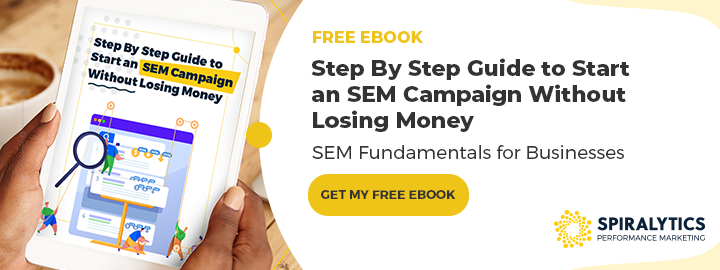Keywords are arguably the most important aspect of any search advertising or SEO campaign. We can help make sure your keyword strategy gets the attention it deserves! Learn more about PPC agency services
What are SEM Keywords?
SEM keywords are words and phrases describing your product or service that you choose to help determine when and where your ad will be displayed in search engine results.
In paid search, you’re paying Google (or other search engines) to show your search ads when someone enters a relevant keyword. Up to 4 PPC ads can be shown at the top of search results. These will be positioned above any organic results, which are generally above the fold.
Certain keywords may convert better than others and there are vast differences in cost-per-click (CPC) when choosing more highly-competitive keywords. That’s why it’s up to brands to decide on the right keyword mix to drive traffic and conversions.
SEM vs SEO Keywords
The main difference between SEM and SEO keywords is “intent”. PPC ad clicks are paid for, while organic clicks are technically free. So, SEM generally focuses solely on high-intent keywords, where clicks have high potential to drive revenue. Naturally, you wouldn’t want to pay for clicks if there wasn’t a good chance they’d convert, right?
On the other hand, SEO’s main goal is to drive organic traffic, so its keyword net is cast a lot wider. There’s a lot more in terms of keyword variation and targeted words/phrases aren’t necessarily intent-focused, as long as they’re somewhat relevant to the brand. Again, organic clicks are free, so websites tend to try and cover as much ground as possible when choosing their target SEO keywords.
How to Research and Select SEM Keywords
The following lists the steps required for your SEM keyword research and selection:
1. Prepare your seed list based on the target model
First things first: a seed list is your initial keyword list and the target model in keyword research is a method of categorizing keywords based on the level of interest or intent that they target.
The target model is useful for keyword research because it ensures that you’ll come up with search terms that are relevant for people interested in products or services that are similar to yours.
There are six categories in the target model, ranked according to their perceived effectiveness in converting potential customers. They are:
- Brand terms – Keywords in this category are all about your brand. Since people are already familiar with your brand and are specifically searching for it, brand keywords can provide the best conversion rates for your business, although they might not necessarily give you the highest search or traffic volume.
- Product terms – This set of keywords is functional and self-explanatory. They describe what your product is, what it does, or what problems it solves.
- Competitor terms – The idea here is that there are customer segments making comparisons between you and your competitors, so don’t leave this one out during your keyword research.
- Substitute product terms – Some customers would search for products that are similar to what you’re offering. For example, someone looking for “parka” might also be searching for “jacket.” Fair warning: These keywords can have higher cost-per-click since Google’s algorithms do not consider them highly relevant for SEM.
- Complementary product terms – These keywords refer to related products or services that might go well with your own and are used by consumers. So, you might want to consider bidding on these terms as well.
- Audience terms – Here, you could target any other word not covered in the other categories, but which your target audience might be searching for. Thinking about how an average customer’s thought process should guide you in adding possible keywords to this category.
2. Use a keyword research tool to build your list
The next thing to do with your seed list is to expand it using keyword research tools such as Google Adwords Keyword Planner. To help you build a good keyword list, you should:
- Choose both specific and general keywords – You can use specific keywords to zero in on customers who are interested in a particular product or service. With specific keywords, your ads will only show each time people search for business-specific terms.
The downside with specific keywords is that you have limited audience reach, which is why you should also mix your keyword list with general search terms. General keywords are broader in scope, so your ads may be shown even to searchers who are looking for something outside of what you’re offering. Be that as it may, the general keywords that you choose should still be relevant to your ad, website, and product/service offering. - Group similar keywords into ad groups – Creating ad groups in your account helps ensure that potential customers will see the most relevant ads, since you’re using groupings to separate keywords that target a particular product, service, or category.
As an example, you could create two ad groups if you’re selling winter coats. One ad group might have the search phrase “winter coats for men,” and the other one includes “winter coats for women.” Customers would then see your ads when they’re trying to shop for coats that they can choose from based on their gender.
Each of your ad groups should contain five to 20 keywords, so think of possible variations in terms and phrases that people are searching for.
Tip: You don’t need to include variations with misspellings or plural versions, as your keywords will automatically match with these entries.
3. Filter through your keyword list
At this point, you want to choose the best keywords for your SEM campaign – the ones that zero in on the intent of searchers. You could refine your list through:
Keyword category
If you refer back to the target model in keyword research, you might notice that your audience keywords will have the most number of keywords compared with the rest of the categories. Refine your list by focusing on the more high-performing categories like brand terms and product terms.
Remember that you’re paying for each click, so you should always optimize your keyword selection to include the highest-converting keywords at the lowest possible CPC. This way, you’ll be lowering your customer acquisition cost (CAC) and maximizing the returns from your campaign.
Match type
Google lets you choose the kind of matching you want to use for your keywords in four different ways:
Use broad match if you want your ads to be triggered every time someone makes a search using words that include any of your keywords. Anyone who searches for “car repair and service” might come across your ad for “car service.”
Use phrase match if you want your ads to be triggered when someone types in a search phrase that matches your entire keyword phrase. Your ad for “car repair and service” will be shown to those looking for “Honda car repair and service.” Using “quotation marks” on your keywords means you’re aiming for a phrase match.
Use exact match if you want your keywords to be identical word for word to the search phrase. In this case, you need to put your keyword phrase in [square brackets].
Use negative match to exclude your ads from irrelevant searches by adding a minus sign before a keyword that are not related to your business. For example, you could add ‘-magazines’ to indicate that your “car repair and service” business does not sell car magazines.
Parting Shot
Researching and selecting the right keywords are the building blocks of your entire SEM strategy. It’s therefore important that you understand what types of keywords work and what types do not.
Your strategy will most likely consist of a mix of short and long-tail keywords. Keep exploring your options – test your keywords, refine your lists, and come up with alternatives. The more targeted and specific your keywords are, the more quality traffic you can expect from your search ads. You can also work with us, the leading SEM company in the Philippines. Let our expertise elevate your online presence and propel your business to new heights!







